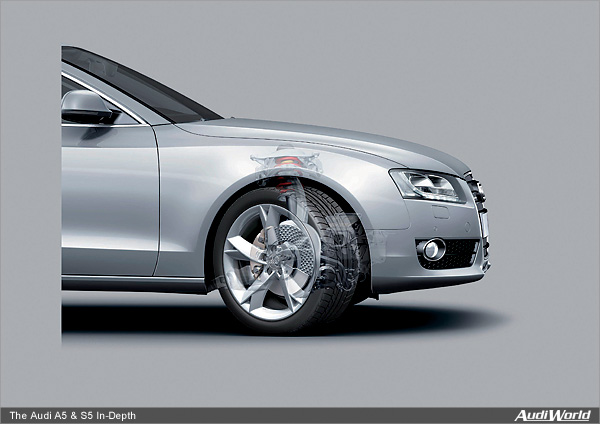The Audi A5: The Running Gear

Precise instruments for agile handling Designing a good grand tourer coupé is a particular challenge to the developers of the running gear, since the cars handling must reflect its sporty performance and elegance at every turn. That means precise steering, high agility and outstanding directional stability combined with excellent ride and suspension comfort, to make even the longest journey a relaxing pleasure. Even when stationary, the Audi A5 makes a dynamic impression: the wide track, large wheels and short overhangs not only characterise its muscular appearance, they also form part of the formula that produces its peerless active driving feel. Audi engineers have achieved this by creating an entirely new running gear design and the result is enough to make the Audi A5 the new standard for its class. New suspension with lightweight design The new five-link front suspension with a wide track of 1,590 millimetres plays a major role in this. The wheels are located by upper and lower wishbones manufactured from aluminium. The lightweight design of the suspension reduces the unsprung weight, thus enhancing driving comfort. The wishbones are mounted on a subframe, which is firmly bolted to the body for high rigidity. The rear running gear features a trapezoidal-link rear suspension with completely new kinematics, also largely made from aluminium. The optimum tuning of the dampers effectively reduces movement of the body while also ensuring very good suspension comfort. Two different sports suspensions are available as options. The sports suspension with high-performance tuning of the springs and dampers for direct road contact guarantees agile handling. The S line sports package features a suspension tuned for an even greater enhancement of handling dynamics, with the body lowered by 10 mm. Another completely re-engineered component is the rack-and-pinion steering. It is located in front of the front axle close to the wheel centre line and enhances the cars very agile handling with its direct transmission of the steering forces. In conjunction with the top engine versions, the 3.2 FSI and 3.0 TDI, the steering is equipped with servotronic speed-dependent power assistance as standard. The steering wheel itself can be adjusted in height by 50 mm and for reach by 60 mm, allowing a relaxed sitting position for drivers of all statures. Long wheelbase, short overhang Overall, the front axle is located a long way forward for a longitudinal engine configuration with front-wheel and four-wheel drive. The new vehicle architecture with an overall length of 4.63 metres allows a long wheelbase of 2.75 metres. That results in a short front overhang and a very good axle load distribution in individual versions of almost 50 to 50 all additional elements that give the Audi A5 its superb handling. To accomplish this special design, the engineers used a trick adopted from the Audi A8: the front axle differential is located in front of the clutch, so the drive shafts and wheels can also be positioned further forward. The generous dimensions of the brakes 16 inches for the A5 or 17 inches for the S5 are designed to match the cars high performance ratings. They allow the braking force to be precisely modulated and provide an excellent pedal feeling. In addition, the kinematics of the new rear suspension significantly reduce the so-called braking dive effect. The front brake discs have an optimised design with a new form of internal ventilation, giving them greater resistance to high stress. The Audi A5 does not have the traditional handbrake lever. Instead, the electromechanical parking brake, familiar from the A8 and A6, is fitted as standard. It is activated and released via a button next to the gear lever or by an automatic function. The A5 is also available with the option of Audi hold assist: this ensures that the car cannot accidentally roll back after stopping on a hill. Integrated driver assistance systems ESP in the Audi A5 is an integrated driving dynamics assistance system comprising the functions of the anti-lock brake system, hydraulic brake assist, electronic differential lock, traction control and, of course, yawing moment control the actual ESP itself. However, this latest version can do even more, such as cleaning the brake discs; this is done by briefly bringing the brake pads into contact with the discs at regular intervals when the car is driven in the rain. The hydraulic fading compensation increases the braking pressure to the required level during extremely heavy use of the brakes. Trailer stabilisation acts to counter incipient snaking by specific application of the brakes. In combination with the cruise control system, automatic braking intervention also maintains a constant speed during downhill driving. This leaves the driver to concentrate on the road. Above all, ESP reduces the vehicles tendency to skid when driven close to its handling limits. Statistics have long established the high effectiveness of electronic stabilisation in preventing accidents and mitigating the consequences of accidents. For particular situations the assistance functions may, however, be deactivated in two stages. The first stage switches off only the traction control system. This allows wheelspin, which may be advantageous, for instance, when driving with snow chains. The second stage completely deactivates ESP and may be used by a skilled driver wishing to make full use of the Audi A5s dynamic handling potential on a suitable stretch of road.
|
